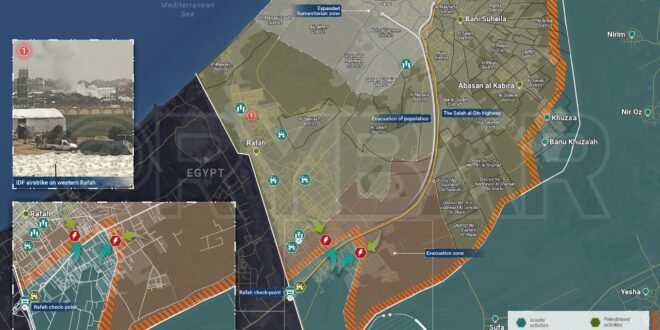The US government said it is against the “unilateral recognition” of a Palestinian state, which should instead be achieved through diplomatic negotiations, according to media reports. Norway, Ireland, and Spain announced on Wednesday that they will formally recognize Palestinian statehood from May 28, in support of the so-called “two-state solution” intended to bring peace to the Middle East.
A White House National Security Council spokesperson told CNN and Reuters that US President Joe Biden is “a strong supporter of a two-state solution and has been throughout his career.” “He (Biden) believes a Palestinian state should be realized through direct negotiations between the parties, not through unilateral recognition,” the spokesperson stated. Over the weekend, Biden said he supported a two-state solution in remarks at Morehouse College’s commencement, calling it “the only solution where two people live in peace, security, and dignity.”
On Tuesday, a US official told reporters that Washington is holding talks about the post-conflict, two-state phase with other Arab capitals and Israel. The two-state solution, a plan to create a Palestinian state within the territory occupied by Israel since 1967, is supported by the UN and many nations. If implemented, it would likely require the removal of Israeli settlers from the occupied territories.
Israeli Prime Minister Benjamin Netanyahu has publicly vowed to prevent Palestinian statehood. Norway, Ireland, and Spain are just the latest Western countries to recognize Palestine. Bulgaria, Cyprus, the Czech Republic, Hungary, Malta, Poland, Romania, and Slovakia did so in 1988, with Sweden joining them in 2014. Russia and China support an independent Palestinian state with East Jerusalem as its capital.
War Termination
The head of the Israeli National Security Council, Tzachi Hanegbi, said Wednesday that “Israel” did not achieve any of the goals of its war on Gaza. “We did not achieve any of the strategic goals of the war, no conditions for a prisoner deal, we did not topple Hamas and we did not enable the residents of the [Gaza] envelope to return to their homes safely,” Hanegbi said during a briefing to the Israeli Foreign Affairs and Security Committee. “They say in the [Israeli forces] that this will take a lot of time, not one year, but years,” Hanegbi added. “The Cabinet did not set any clear goal for the north, no dates, no targets, no strategic goals,” he added.
Qatari Foreign Ministry spokesman Majed Al-Ansari confirmed that mediation efforts by Qatar, Egypt and the United States are continuing for an immediate and permanent ceasefire in the Gaza Strip. Al-Ansari added, “The mediation efforts of Qatar, Egypt and the United States are continuing to exchange prisoners and detainees and to achieve peace, security and stability in the region.” He explained that “Qatar calls for not paying attention to media reports questioning the ongoing mediation efforts to stop the aggression against Gaza.” He also stressed “the need for the focus, at this sensitive time, to be on ways to end the war in the Gaza Strip.”
A senior Israeli official revealed Tel Aviv’s intention to return to Qatari mediation in efforts to release hostages held by Hamas in the Gaza Strip. Commenting on the CNN report, a high-ranking Egyptian source expressed on Wednesday Cairo’s astonishment at ” the attempts of some parties to deliberately insult the Egyptian efforts made to reach a ceasefire in the Gaza Strip.” He explained that “some parties are playing a game of constantly accusing the mediators, accusing them of bias and blaming them for evading making the required decisions.”
US Secretary of State Anthony Blinken announced that Washington and Riyadh may complete preparations for their part of the agreement to normalize relations between Saudi Arabia and Israel in the coming weeks. Blinken said during a hearing in the US House of Representatives: “We are continuing to work to try to reach this agreement (normalizing relations between Saudi Arabia and Israel). This will require some understandings and agreements between the United States and Saudi Arabia in the areas of security, nuclear energy and defense cooperation. These agreements, in terms of “The principle is very close to being concluded now, but it may be several more weeks before it is completed.”
He pointed out that Saudi Arabia “clearly demonstrated” that if the part of the deal with the United States is completed, and in order to continue the process of normalizing relations with Israel, “they need calm in the Gaza Strip and a reliable path towards establishing a Palestinian state.” Blinken added that the United States “wants to see this and that” and continues to work to achieve this. But he found it difficult to answer the question about “whether the Israeli government is ready to act now on this basis.”
The Israeli Broadcasting Corporation announced yesterday that US National Security Advisor Jake Sullivan is “disappointed ” after a series of meetings with senior Israeli officials, including the Prime Minister, Defense Minister Yoav Galant, Minister Benny Gantz, Chief of Staff Herzi Halevy and other officials. He put on the table for discussion a number of issues, including Rafah, the prisoner exchange deal, and normalization with Saudi Arabia.
Operational Update
Following the alert in the Ajar area a short time ago, this is a false alert. Further to the alerts that were activated in the areas of Dafna and Mayan Baruch in the north of the country, these are false alerts.
Tomorrow (Thursday), starting in the morning until noon, a military exercise will take place in cooperation with the security forces in the area of the city of Eilat and the Eilot Regional Council. During the exercise, a lively movement of vehicles and many security forces will be felt in the area. The exercise was planned in advance as part of the IDF’s annual training plan for 2024, and as part of the IDF and security forces’ readiness in the city for the various threats in all sectors.
The Chief of Staff, Lt. Gen. Hertzi Halevi, visited today (Wednesday), the exercise of the reserve brigade “Hafti Hash” (551) for readiness for the North, with the participation of the commander of the Northern Command, Major General Uri Gordin, the commander of the land arm, Major General Tamir Yedai, the commander of the National Center For training on land, Brigadier General Kobi Heller, commander of the 551st Brigade, Col. Ido Kess and other commanders.
“Fighting in Gaza, or in Lebanon, requires tenacity,” stated the Chief of Staff, Lt. Gen. Herzi Halevi, “there are no easy achievements. And we need to be much more tenacious than the other side, much more tenacious. And we are looking forward, and you will see, the way to bring the residents back At the northern border with security, she also goes through a lot of talent and proper planning and a lot of stubbornness.”
“Look at the brigade with a lot of work, a lot of experience, a lot of achievements along with a price, which we are well aware of,” he continued, “but I tell you, we are determined, persistent, also ready for challenges in the north, also in action in the south, also in fighting Terrorism in IOSH. And with that we are moving forward, very much trusting the people, very much trusting the reservists that this strong presence gives a lot of confidence both in readiness and professionalism. Train, lift up, we will move forward.”
Operational Update – Gaza
Politico reported that US intelligence, in its latest assessments, said that Israel was only able to eliminate about 30%-35% of Hamas fighters from October 7, 2023. The US intelligence assessment revealed that 65% of Hamas’ tunnels are still active, indicating that Hamas has been able to recruit thousands of new fighters. The newspaper indicated that the Biden administration has become increasingly concerned about Hamas’s ability to recruit thousands during the past few months during wartime, and this has allowed them to withstand Israeli attacks for months.
The newspaper explained that it is possible that these and other intelligence assessments contributed to the startling recent comments made by senior administration officials. Politico newspaper said that the administration of US President Joe Biden has become publicly critical of the Israeli military strategy in Gaza after it had been secret for a long time. Politico stated that this level of criticism of the Middle East ally has not been seen since the war began in October 2023, noting that Washington, over the course of months, quietly pushed Israel to change the way it wages its war on Gaza, but the frustration resulting from watching Israel refuse to change its course has spread increasingly. To the public and widen the gap between Washington and Tel Aviv.
The Biden administration fears that Israel may disastrously squander its chance to achieve victory over Hamas and lose its best chance to eliminate the movement’s control of the Strip. Senior officials publicly describe Israel’s strategy in Gaza as self-defeating and likely to open the door to the return of Hamas. The newspaper pointed out in the context that the result is that Hamas is still clinging to the land and retains great capabilities, even after the comprehensive war launched by Israel over a period of nearly eight months.
Officials said the Israeli government failed to control parts of Gaza after it was cleared, turned the civilian population and the rest of the world against it through widespread bombing and inadequate humanitarian aid, and enabled Hamas to recruit more fighters. An official told the newspaper that National Security Advisor Jake Sullivan used his meeting with Prime Minister Benjamin Netanyahu in Israel last week to discuss how the military operation could lead to achievable and lasting success against Hamas.
In an interview on Tuesday with CNN, Netanyahu said: “We have to get rid of Hamas or there will be no future for Gaza,” but US intelligence, in its assessment, raises growing concerns that such an outcome is not possible. Western officials believe that while Israel has weakened Hamas’ capabilities in Gaza, Hamas has been able to protect thousands of its fighters, many of whom operate and hide within a sprawling tunnel network and others believed to mingle with the civilian population.
The officials said that “Israel” has turned the world against it with its continuous bombing and blocking of humanitarian aid, which they claim has enabled the Palestinian Resistance to recruit more fighters. A person familiar with US intelligence revealed that Biden officials are becoming increasingly concerned that Hamas has been able to recruit during wartime which has allowed them to withstand the 7 months of conflict.
Recent satellite images showed the massive destruction left by the recent Israeli attacks on the city of Rafah, south of the Gaza Strip. Although Israel describes the ground incursion as “limited,” it is “practically a deep ground operation,” according to the Israeli newspaper Haaretz , which described the destruction in the southern Gaza Strip as “similar to the destruction seen in other cities throughout the Gaza Strip.” Gaza during the early stages of the war. The latest satellite images were taken on May 19 by the private satellite company Planet Labs, and show that the Israeli army has flattened several buildings between the Kerem Shalom border crossing and the Rafah crossing.
This type of satellite imagery is considered extremely important for monitoring the progress of the war, as the army imposes severe restrictions on the entry of journalists into Gaza. The Israeli army’s ground incursion into Rafah began on May 6, when the army ordered residents in parts of the area to quickly evacuate. Israeli forces entered through the Kerem Shalom crossing, and moved north along the Philadelphia axis, parallel to the Egyptian border.
The brigade combat teams of the 162nd division, joined by the Nahal TKS, continued their offensive activity in Rafah tonight. The forces are now acting precisely following information about terrorist targets in the area of the ‘Brazil’ neighborhood and the ‘Shabura’ area while preventing as much as possible harm to the civilian population, after the citizens have evacuated the area. The activity began with a preliminary attack flight of fighter jets of the Air Force against Hamas terrorist targets in Rafah.
In the last day, the forces of the 98th Division operating in the Jabalia area in the north of the Gaza Strip have eliminated many terrorists in face-to-face battles and by directing attacks by Air Force aircraft and fighter jets. In one of the attacks, the fighters of the paratrooper brigade directed an aircraft that eliminated eight terrorists from the terrorist organization Hamas who were staying in a weapons warehouse.
The terrorists who were eliminated were operating in the fields of rockets, operating drones and observing Israeli forces. Soldiers of the 679th Israel Defense Forces have killed a number of terrorists in the center of the Gaza Strip in clashes and tank fire in the last day. Earlier today, IDF forces identified terrorists entering a military building in the Mis al-Jabal area, shortly after the identification, fighter jets attacked the building where the terrorists were staying.
Soldiers of the TSK 401 are operating in the Rafah area against terrorist targets, along with advancing on the Philadelphia Axis with the help of which they managed the fighting in the last few days. The fighters of the brigade located and destroyed launch sites that were loaded and ready to fire towards Israeli territory with several canisters. The launch sites are located in East Rafah on the Philadelphia axis near the border. All the launchers were destroyed.
The fighters of the 7th Brigade Combat Team are fighting in a lumbering manner in the Jabaliya area. So far, the forces have destroyed dozens of terrorist infrastructures, attacked about 100 targets from the air and fired about 500 artillery shells. The forces raided dozens of Hamas combat compounds. As part of the effort to destroy the military’s capabilities, the forces located and destroyed a number of ready-to-use launchers and dozens of rockets. In addition, during the searches, the forces located weapons, including explosive belts, ready-to-use charges, grenades, weapons and ammunition.
Led by the Gaza Division and under the intelligence guidance of the Amman and the Shin Bet, fighter jets attacked a compound inside a UNRA school where Hamas terrorists were operating, including an anti-tank operative and a Nakhaba terrorist. In the compound that was attacked there were weapons including mortars, weapons and explosives. The attack was carefully planned and carried out using precise weaponry and avoiding harm to those not involved as much as possible. At the end of the destruction of the compound, many secondary explosions were detected which testified to the presence of weapons in the area.
Led by the Gaza Division, Amman and the Shin Bet, an Air Force aircraft attacked and killed in Khan Yunis the terrorist Ahmed Yasser al-Kara, a key anti-tank operative in the terrorist organization Hamas who led attacks and terrorist plots against IDF forces during the war and was monitored by Southern Division. Al-Kara took part in the terrorist attack in the Gaza Envelope on October 7 and during the fighting he made many shooting attempts at our forces in the Gaza Strip. During the preparation for the attack, Unit 414 identified a child near the terrorist, so they stopped the attack immediately after the identification. After the boy moved away from the building, the attack was carried out in which two more terrorists were killed: Zahib Ra’ad Abu Riva, a Nakhaba terrorist in the Hamas terrorist organization, and Anas Muhammad Abu Hasliha, a terrorist in the GAP terrorist organization.
In addition, Air Force fighter jets, under the direction of the Southern Command and the Intelligence Wing, killed five Hamas terrorists who were operating out of the ‘Fahmi Aljarjaoui’ school compound in the Derg Tafah area in the northern Gaza Strip. Among the terrorists who were killed in the attack, the terrorist Fadi Salim, head of the information system in the organization’s Gaza division. Along with him, three terrorists in the organization’s intelligence system and another Nakhaba terrorist were killed. This is another example of the cynical and clear use that the terrorist organization Hamas makes of civilian spaces and facilities while using the Gaza population as a human shield.
The Philadelphia axis is considered a “buffer zone” and is subject to the peace agreement between Egypt and Israel, but two weeks after the Israeli military operation in the city of Rafah on the Egyptian border, the Israeli army took control of “half of the axis,” according to its assurances to the “Al-Hurra” website, which raised questions about the reasons and repercussions. On May 14, eyewitnesses reported seeing tanks crossing the strategically important Salah al-Din Road to the Brazil and El Geneina neighborhoods, according to the British newspaper The Guardian. On May 15, CNN reported that Israeli forces took control of parts of the “Philadelphia Axis.”
Israeli forces advanced deep into Rafah, and the Israeli army took control of more than half of the Philadelphia axis, which is also called “Salah al-Din Road,” according to what Yedioth Ahronoth newspaper reported on Tuesday. This is what the Israeli Army Spokesperson Unit confirms to Al-Hurra website, and says: “This matter is real,” in reference to controlling half of the Philadelphia axis. But the unit refused to give the reasons for taking this step, or talk about the extent of the possibility of controlling the entire Philadelphia axis during the coming period.
The Philadelphia Axis, also called the “Salah al-Din Axis,” is located along the border between the Gaza Strip and Egypt, and is 14 km long. Israeli military and strategic expert, Kofi Lavie, believes that controlling the Philadelphia axis “is very important in light of the complex situation on the border between Israel and Egypt.” He pointed out that “all tunnels that were discovered in the Philadelphia axis must be destroyed,” as he put it.
Last January, the head of the Egyptian State Information Service, Diaa Rashwan, said in response to statements by Israeli officials, in which they indicated the existence of weapons smuggling operations into the Gaza Strip from Egyptian territory, considering them to be “false allegations and allegations.” In a related context, Israeli political analyst Eddie Cohen points out that “Israel seeks to eliminate the Hamas movement, and this will not be done except by fully controlling every area in the Gaza Strip.” He says that Hamas obtained “weapons and technology through tunnels,” “with or without the knowledge of the Egyptian side,” which prompted the Israeli army to “seize and control the Philadelphia axis,” according to Cohen.
The Israeli political analyst, Mordechai Kedar, agrees with him, who talks about “the smuggling highway through tunnels between Egypt and the Gaza Strip.” Kedar told Al-Hurra website that seizing the Philadelphia axis will enable Israel to “stop and eliminate the smuggling movement through tunnels.”
Egypt is the first Arab country to sign a peace agreement with Israel on March 26, 1979, a year after the signing of the Camp David Accords in 1978. Under the peace agreement, Cairo was able to recover the Sinai Peninsula, which Israel controlled in 1967, and Egypt fought a war to regain it in 1973. The “Salah al-Din” axis, or Philadelphia, is considered a “buffer zone” by the peace treaty signed in 1979, and Israel withdrew from it completely as part of the plan to disengage from the Gaza Strip in 2005.
Al-Hurra website contacted the head of the Egyptian State Information Service, Diaa Rashwan, to clarify the “official Egyptian position” on the Israeli move, but we did not receive a response until the time of publishing the report. Speaking to Al-Hurra website, Imad Gad, advisor to Al-Ahram Center for Political and Strategic Studies, points out that “Israel is trying to impose a fait accompli policy on Egypt,” by controlling parts of the Philadelphia axis. Israel will continue its quest to control the entire axis, and they will not listen to the Egyptian side until the plan to “eliminate the main force of the Hamas movement” is completed, according to Gad. The advisor to Al-Ahram Center for Political and Strategic Studies denies what Israeli analysts said about “arms smuggling from Egypt to the Gaza Strip,” and says: “This is not true, and it is the same exhausted and inaccurate allegations… and the same outdated arguments.” The opposite is true. Egypt suffered from weapons smuggling through tunnels that came from “the direction of the Gaza Strip towards Egyptian territory,” and Cairo made “every effort to close all of these tunnels,” according to Gad.
For his part, the Egyptian military and strategic expert, Major General Staff Samir Farag, explains that “the region is buffered according to the peace agreement, but Israel is trying to escalate the situation with Egypt and drag it into other problems.” The lands of the Philadelphia Axis are “not Egyptian,” but what is currently happening by the Israeli army is a “violation of the peace agreement” between the two countries, according to what he told the Al-Hurra website.
In a related context, the Egyptian military and strategic expert, Major General Al-Sayyid Al-Jabri, stresses that Israeli control of the Philadelphia axis “threatens the peace agreement between Egypt and Israel.” The essence of the peace agreement between Egypt and Israel is “the absence of any military forces in the buffer or separation zone,” as he explains to the “Al-Hurra” website. The entry of armored vehicles and artillery weapons is “a clear violation of the essence of the peace agreement,” which gives Egypt the right to “rearrange the situation of its armed forces in the entire Sinai.”
The ” Peace Agreement ” allows Israel and Egypt to deploy forces limited in number and equipment, and limited in numbers and types of weapons and vehicles, with the aim of patrolling the side of the Egyptian axis, to prevent smuggling, infiltration, and other criminal activities. The agreement provides an Israeli presence within this buffer strip, known as the Philadelphia Axis, which is located within Area D in accordance with Annex I, the Protocol on Israeli Withdrawal and Security Arrangements, which allows the presence of a limited Israeli military force of four infantry battalions, field fortifications, and United Nations observers.
The Israeli force does not include any presence of tanks, artillery, or missiles, except for individual “surface-to-air” missiles. The Israeli infantry forces in this area can have up to 180 military vehicles, with a total number of infantry not exceeding 4,000.
In Area D, including the Philadelphia axis, the Israeli forces controlled this until they withdrew from it and handed it over to the Palestinian Authority in 2005.
In Area C of the agreement, the presence of United Nations forces and the Egyptian civil police is allowed.
In Area B, Egyptian border units of four battalions equipped with light weapons are allowed.
In Area A, there are military forces consisting of an infantry division, an armored brigade, and artillery brigades, not exceeding 22 thousand Egyptian soldiers. To arrange an Egyptian presence for border guard forces, the “ Philadelphia Agreement ” was signed, which is in line with the “Crossings between Israel and the Palestinian Authority” agreement that was signed in the same year. For his part, Cohen confirms that Israeli forces will remain in the Philadelphia axis in order to “stop and prevent the introduction of weapons from Egypt to the Hamas movement.” As for Kedar, he points out that “Israel does not want to harm Egyptian national security from near or far, but if Cairo had done its duty and stopped the smuggling movement under the Philadelphia axis, Hamas would not have had the current power.”
The Egyptian and Israeli sides must sit down to “negotiate, discuss and reach understandings” on the Philadelphia axis, according to the Israeli political analyst. For his part, Lafi talks about internal pressures in Egypt and Israel to “tamper with relations and each party accuses the other of not fulfilling its duties.” But there must be a “military understanding” of the importance of relations between the two countries, as the Israeli military analyst points out. According to Lavi’s estimates, the Israeli army’s control of the Philadelphia axis “will not affect relations between Egypt and Israel.”
But on the other hand, Gad asserts that what Israel is currently doing is “a violation of the security annex of the peace treaty.” It is assumed that there will be “an angry, practical Egyptian reaction by diplomatic protest or withdrawal of ambassadors,” according to an advisor to the Al-Ahram Center for Political and Strategic Studies. In a related context, Major General Farag points out that “Egypt will not submit to Israeli provocations, and will take diplomatic paths to respond to the violation of the peace agreement.” Regarding the diplomatic tracks, the Egyptian military and strategic expert explains that they relate to Cairo informing Washington, as the “guarantor of the peace agreement,” that the Israeli moves violate that agreement.”
Egypt can also “go to the Security Council” and file a complaint against Israel as it “violated an international agreement,” according to Major General Farag. But Major General Al-Jabri talks about 3 future scenarios after the Israeli forces took control of half of the Philadelphia axis. The first scenario is “the withdrawal of Israeli forces from the axis and not clinging to the land,” but if “the Israeli army clings to the land,” friction may occur between “the Egyptian border guards and the Israeli forces,” according to Major General Al-Jabri. Al-Jabri talks about the third scenario, which is “the occurrence of clashes or escalation between the Egyptian and Israeli sides,” something whose “repercussions cannot be predicted,” and the military situation may develop “very quickly.” At that time, “the form of the conflict will change and there will be a new reality in the entire region,” according to the warnings of the Egyptian military and strategic expert.
Operational Update – Judea-Samaria
Palestinian Resistance fighters confront Israeli occupation forces raiding the Jenin refugee camp in the occupied West Bank, leading to the martyrdom of several people. The al-Quds Brigades, the military wing of the Palestinian Islamic Jihad (PIJ) repelled an Israeli forces unit in the Jenin refugee camp in the northern occupied West Bank. Palestinian media sources said the Resistance fighters engaged in fierce confrontations with the occupation forces in the Damaj neighborhood inside the Jenin refugee camp.
The al-Aqsa Martyrs Brigades, the military wing of the Fatah Resistance movement said that it engaged in fierce confrontations with the Israeli occupation forces in the al-Damaj neighborhood inside Jenin refugee camp. Israeli media reported that an IDF officer was hit by an explosive device in Jenin, adding that a soldier from the undercover force was injured in Jenin in the West Bank.
The Israeli forces carried out a large raid on Palestinian homes in the al-Damaj neighborhood in the Jenin refugee camp and arrested several Palestinians, including Hilal Jaramneh, a woman from the al-Hamid family, and Yazan Ali Samoudi, who sustained several gunshot wounds after being shot by the Israeli occupation forces in Jenin. The Palestinian Red Crescent Society (PRCS) announced that its teams managed to reach a martyr in Jenin, raising the death toll to eight following the Israeli occupation’s large-scale invasion of the city, which began earlier on Tuesday. Additionally, the PRCS reported that at least 21 Palestinians have been injured, with some injuries considered severe.
The PRCS stated that its teams reached an unidentified martyr in the al-Hadaf neighborhood in Jenin before Israeli forces seized the ambulance while it was transporting the martyr to the hospital for identification and later burial. Moreover, the PRCS added that Israeli forces targeted their ambulance with live bullets in the al-Hadaf neighborhood while it was heading to assist the injured, causing damage to the vehicle.
As part of the ongoing operation, the Israeli forces called for reinforcements to Jenin, as confirmed by local Palestinian media. The Israeli forces continued their military operation and expanded throughout several neighborhoods in Jenin and its camp. In turn, Al Mayadeen’s correspondent reported that Israeli bulldozers worked on destroying infrastructure near Jenin Governmental Hospital and obstructed ambulance crews from reaching the injured, including school students.
In a continuation of its systematic operations against cities, towns, and camps in the West Bank, Israeli forces stormed several areas. In the northern West Bank, forces from the Israeli army entered the city of Qalqilya, arresting the parents of young Tareq Dawoud after raiding their home to pressure him into surrendering, according to local Palestinian media. In the central West Bank, cities west of Ramallah were also stormed.
Operational Update – Lebanon
Air Force fighter jets attacked military buildings of the terrorist organization Hezbollah in the Eyta al-Sha’ab area, alongside observation posts of the organization in the Alma al-Sha’ab area in southern Lebanon. IDF fighters, Shin Bet, MGB fighters and undercovers continue the operation in Jenin to thwart the terrorist infrastructures located in the area. As part of the operation, the forces exchanged fire with armed men and killed a number of terrorists, including two terrorists who threw explosives at the forces. In addition, the fighters confiscated military equipment and uncovered charges that were planted under the axles and were intended to harm the troops. Yesterday (Tuesday), a gunman was identified in Jenin who entered the government hospital area and barricaded himself in it. This is another example of the cynical use by armed men in the Jenin area of humanitarian infrastructure including hospitals as shelters and hiding places.
Fighter jets attacked two Hezbollah launchers in the areas of Marvin and Aita al-Sha’ab in southern Lebanon. In addition, warplanes attacked a terrorist infrastructure of Hezbollah in the Rav al-Taltin area. Also, an explosive UAV that crossed Lebanese territory fell this evening in the area of Beit Hillel, there were no casualties and no damage was caused.
Operational Update – Syria / Iraq
Operational Update – Yemen
Al-Masirah TV, affiliated with the Houthi Ansar Allah movement, reported on Wednesday that Hodeidah International Airport in western Yemen was targeted by a series of air strikes by American-British aircraft. According to the channel, American and British aircraft launched 6 raids on Hodeidah Airport, without giving further details about the material or human damage.
It should be noted that this is not the first time that Hodeidah International Airport has been targeted. Since the beginning of this month, American and British aircraft have launched a series of raids targeting the airport. On May 2, they carried out about 5 raids on Hodeidah Airport, and on the 13th of this month, they launched an air strike on the airport. On the 14th, it launched 4 raids targeting the airport and its public facilities south of Hodeidah.
Hodeidah overlooks the Red Sea, and it is one of the most important governorates in Yemen, as it contains an international airport, in addition to having a long coastal strip. Since last November, the Houthis in Yemen have been carrying out attacks in the Red Sea on Israeli ships or those heading to Israel, “in support and victory for the Palestinian people and Gaza.”
Bloomberg reported that the Pentagon confirmed that the Houthis are using weapons that can reach the Mediterranean. The US government is concerned that the Houthis have the ability to expand strikes on shipping beyond the Red Sea and Gulf of Aden into the Mediterranean, said an official who requested anonymity to discuss the private talks. He added that the Ansar Allah group in Yemen has advanced weapons and that their deployment of anti-ship ballistic missiles is almost unprecedented, in addition to their use of drones in their attacks. This assessment came as defense officials from the United States and the Gulf Cooperation Council met in Riyadh, Saudi Arabia. The United States seeks to use this group to achieve greater integration in air and missile defenses, including the exchange of radar data and the development of early warning capabilities.
Al-Monitor reported that the Houthis in Yemen warned early this month that they would expand their ongoing campaign of attacks on commercial ships in the Red Sea to include ships in the Mediterranean . The Houthis have launched more than 90 attacks on commercial ships in the Red Sea and Gulf of Aden since November 2023, and also struck at least one commercial ship linked to Israel in the Indian Ocean about 300 miles east of the African coast in late April.
Maps
All maps are lies. “Not only is it easy to lie with maps, it is essential,” wrote cartographer Mark Monmoneir in his book How to Lie with Maps. He showed that condensing complex, three-dimensional spaces onto a two-dimensional sheet of paper [in old days] is bound to be reductive.
But it is impossible to comprehend the war in Gaza without reference to maps, otherwise the entire conflict is reduced to an endless series of meaningless acts of random violence and the suffering of civilians. The first characteristic of guerrilla warfare is the loss of a front line.
Evidently, different mappers have different ideas of how to depict the war in Gaza, notably those that seek to depict Israeli progress in the ground campaign. Part of the problem is latency. The news that forms the basis of the maps takes time to filter out to mappers, and the cartographers take time in crafting their maps, and it takes time to curate them. These processes are uneven among mappers, so their maps may differ in detail. Probably there is some ideological bias, or at least thematic apperception, which is understandable in wartime. It may come as no surprise that al-Jazeera maps depict rather less Israeli territorial progress than other sources.
Finally, there remains the epistemological question of just exactly what are the colored in areas depicting. Naively, this might be understood as areas of Israeli control, that are no longer contested by the HAMAS. Or possibly these are areas of Israeli presence, in many of which the possibility of an RPG-wielding HAMAS militant popping out of a tunnel unexpectedly remains a live possibility. With the “zero-range” combat characterized by small unit tactics on both sides, maps may be prey to a fallacy of misplaced concreteness.
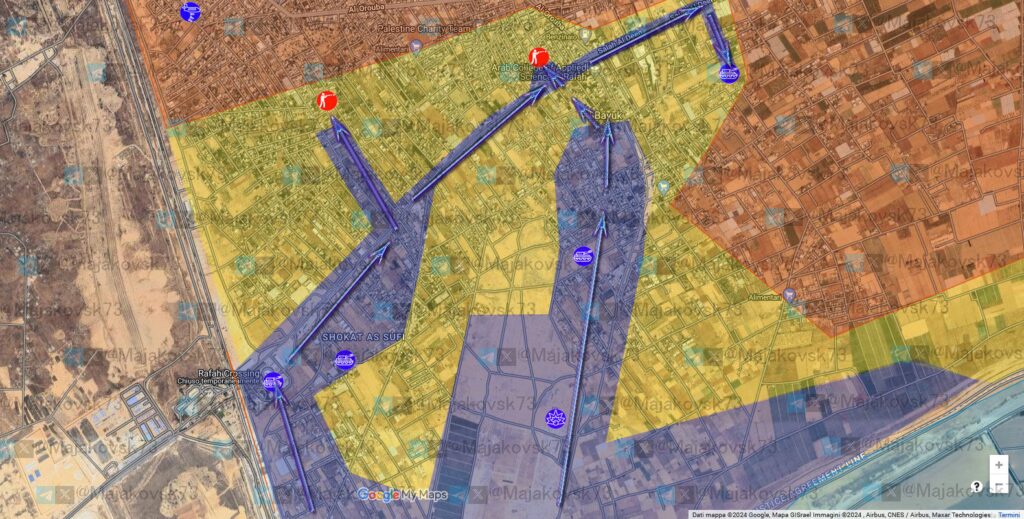
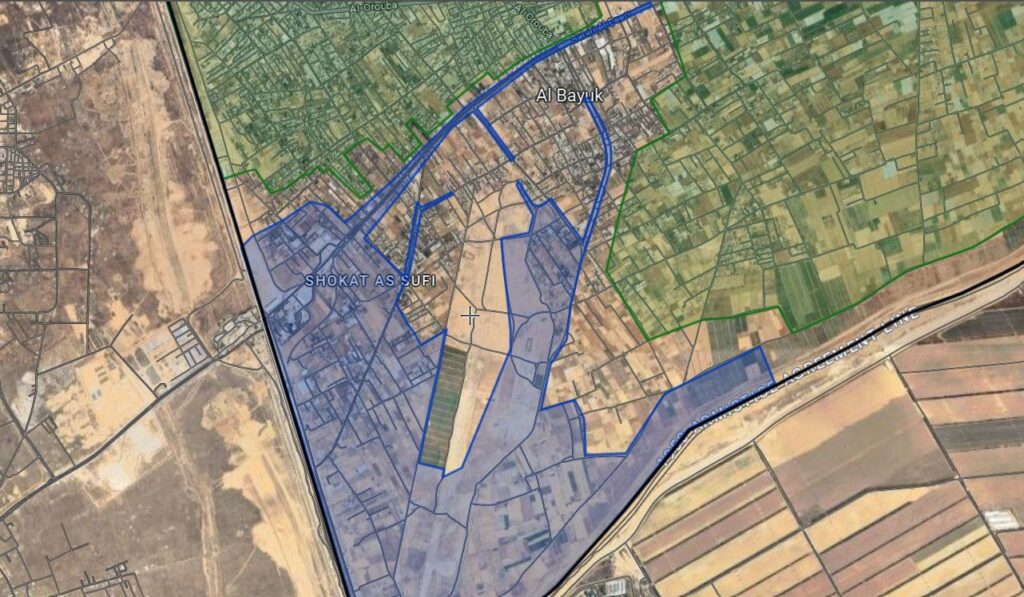
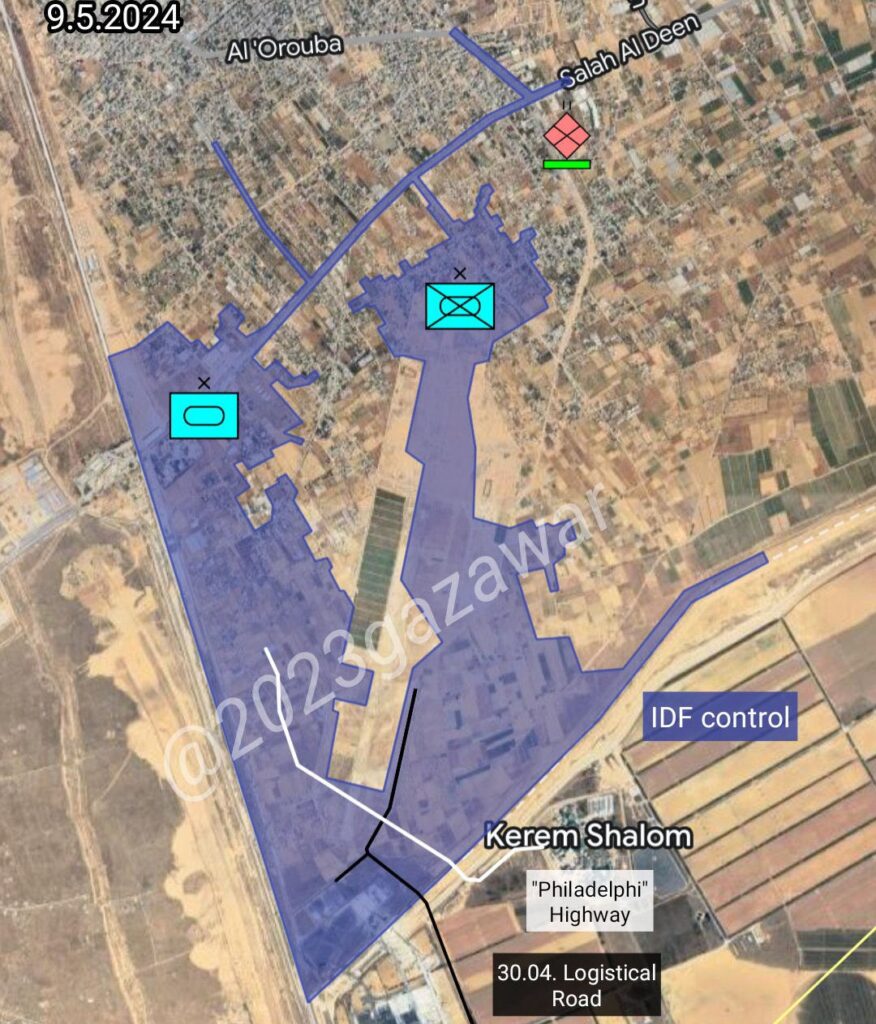
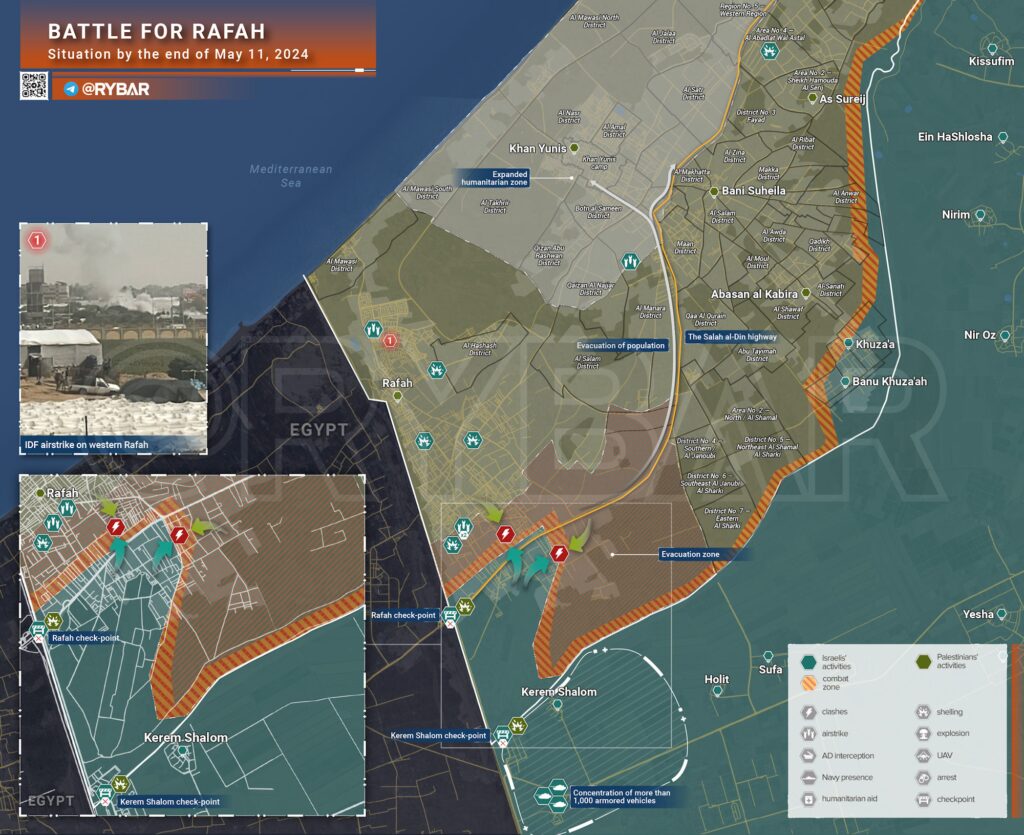
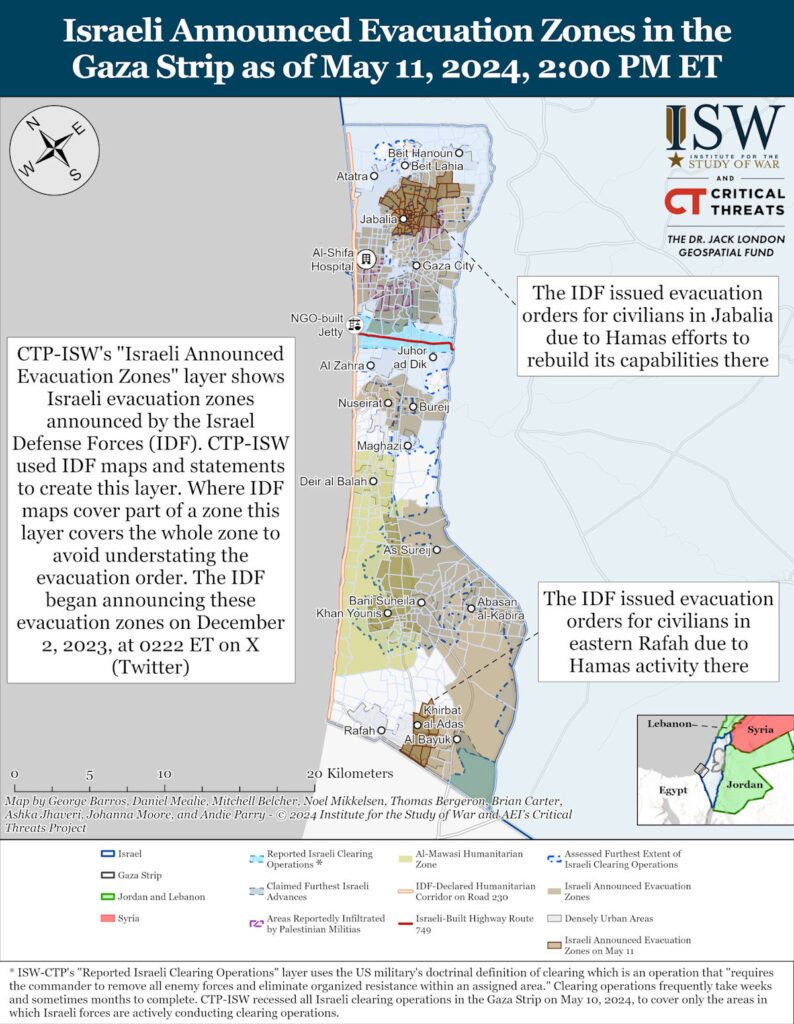
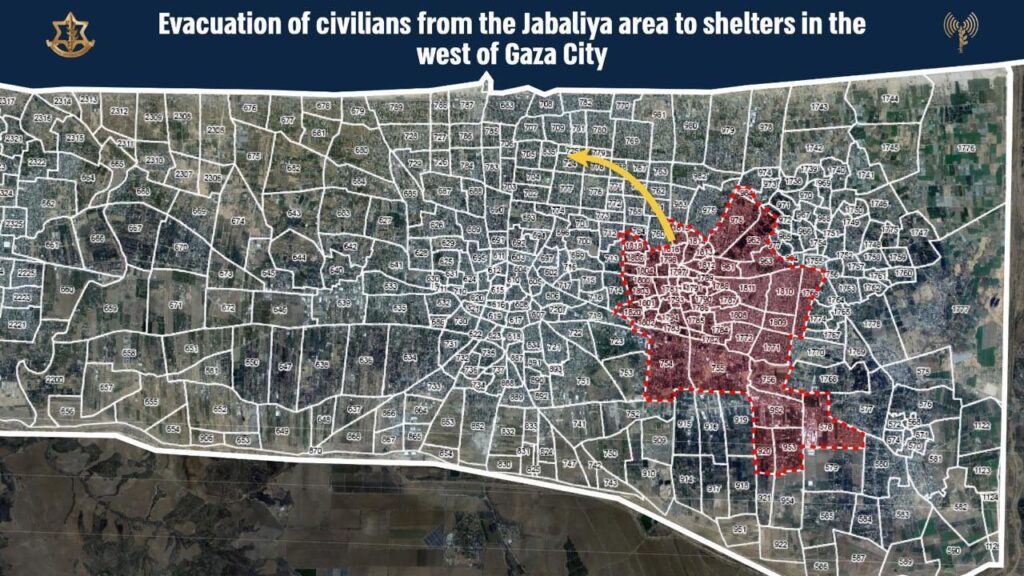
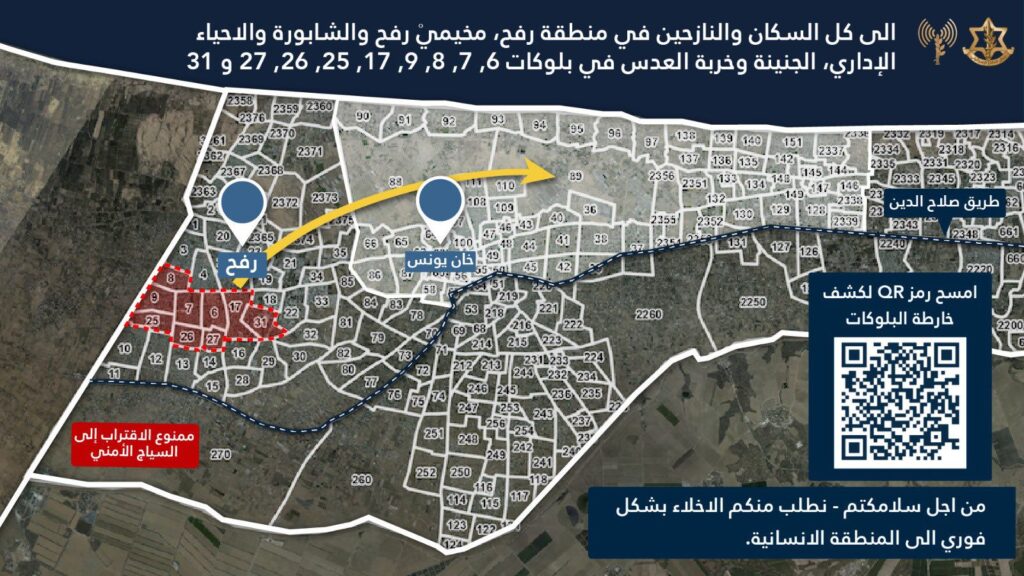
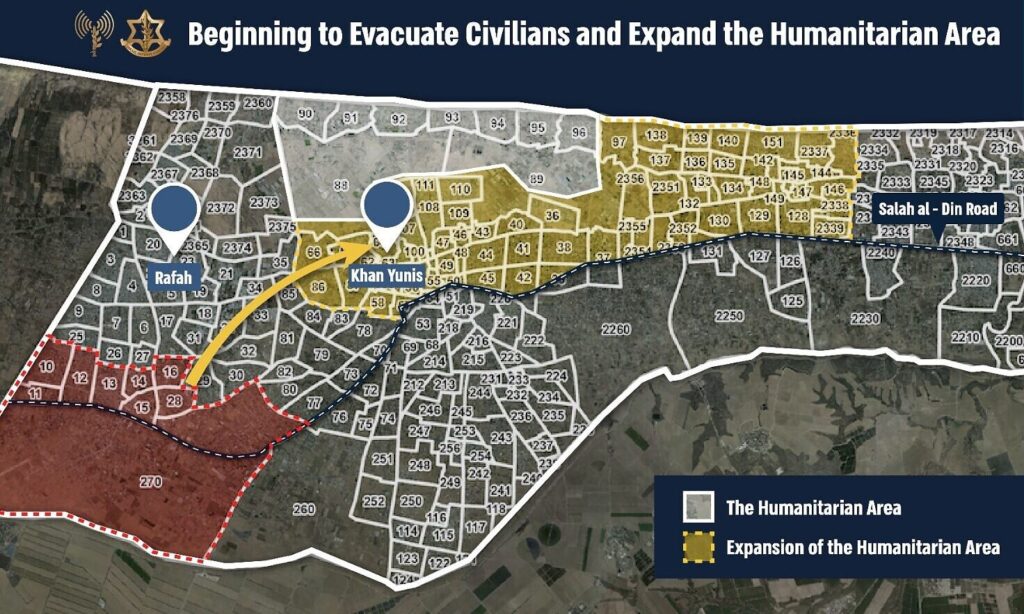
Bystanders
Norway, Ireland and Spain announced plans to join the growing bloc of European countries which recognize Palestinian statehood. Israel recalled its ambassadors to Norway, Ireland and Spain on Wednesday for “urgent consultations,” summoning envoys in Tel Aviv and threatening the countries with “severe consequences” after the trio announced plans to formally recognize Palestine – likely based on its pre-1967 borders, starting next week.
“Israel will not remain silent in the face of those undermining its sovereignty and endangering its security,” Israeli Foreign Minister Israel Katz said in a statement after the recognition announcement. “Today’s decision sends a message to Palestinians and the world: Terrorism pays,” Katz alleged, accusing the three countries of “choosing to reward Hamas” with statehood after its surprise incursion into southern Israel last October.
Palestinian Authority President Mahmoud Abbas welcomed the trio’s move, saying it will help enshrine “the Palestinian people’s right to self-determination” and bring a two-state solution closer to reality. Hamas – which doesn’t recognize Israel’s right to exist – also welcomed the development, calling it “an important step on a path to establishing our right to our land,” and urging more countries to follow suit.
A White House National Security Council spokesperson rushed to Israel’s defense, emphasizing that while President Biden “is a strong supporter of a two-state solution and has been throughout his career,” he believes a Palestinian state “should be recognized through direct negotiations between the parties, not through unilateral recognition.” The “direct negotiations” the spokesman mentioned refer to an effort by Washington to broker a Palestinian-Israeli settlement – with talks failing spectacularly over the course of more than three decades thanks largely to Israeli intransigence, US favoritism for Tel Aviv and efforts by Israeli leaders, including Prime Minister Netanyahu, to divide the Palestinian liberation movement.
French Foreign Minister Stephane Sejourne criticized the three countries’ move, saying that recognition was “not just a symbolic issue or a question of political positioning, but a diplomatic tool in the service of the solution of two states living side by side in peace and security.” Sejourne suggested conditions are not ripe to recognize Palestinian statehood. A spokesperson for Germany’s Foreign Ministry echoed Washington and Paris’s sentiments, saying Berlin would realize its “firm goal” of recognizing an independent Palestine only through a “dialogue process.”
Sweden became the first Western European country to recognize an independent Palestinian state, doing so in 2014, 26 years after five former Eastern Bloc countries including Bulgaria, the Czech Republic, Hungary, Poland, and Romania did so in 1988, together with Cyprus. A total of 143 of 193 members of the United Nations, including Russia, every country in the Middle East and South America, most of Africa and Asia now recognize Palestinian statehood, with Wednesday’s announcement shrinking the bloc of Western countries which have not done so.
Norway, Ireland and Spain represent a unique group of countries in terms of socio-economic development and political persuasion. Norway, for example, is not a member of the European Union, and while it was one of the first countries to recognize Israel in 1949 and boasts a “long history of friendship” with the Jewish State, it has also been highly critical of Israel’s occupation of East Jerusalem, and of the brutality of Tel Aviv’s military operations in Gaza after October 7.
Spain and Israel only established relations in the mid-1980s, and while ties quickly warmed after that, they worsened dramatically last October, when several Spanish officials recommended that Prime Minister Netanyahu be brought before the International Criminal Court on war crimes charges. This prompted Tel Aviv to accuse the Spanish government of sympathies with terrorists. Spain, interestingly, is only of the few NATO allies which has not recognized the US-sponsored puppet regime in Kosovo, Serbia, indicating at least some readiness to act against Washington’s interests when Madrid sees fit.
Ireland has also had a rocky relationship with Israel, with embassies between the two countries set up only in 1996, and Dublin regularly criticizing Tel Aviv over its threat to Irish peacekeepers serving in the UN-led peacekeeping force in southern Lebanon, over the construction of the West Bank security wall, and over illegal Mossad operations on Irish soil.
“Of course recognizing Palestinian state is a big step – it is significant,” Dr. Mehmet Rakipoglu, an assistant professor at the Mardin Artuklu University in Turkiye, told Sputnik. Rakipoglu believes the three countries have been outside the US and Israeli orbit politically for some time, with some, like Ireland, sharing a special sympathy for the Palestinians based on their own experience of suffering at the hands of British imperialism. “So, of course, this is a big failure of US diplomacy,” the observer stressed.
“This is a normal failure of Israeli diplomacy, not [only] in these countries, but also at international level,” Ayman Yousef, professor of political science and international relations at the Arab-American University in Palestine, told Sputnik. “It will have very good implications for other countries within the EU to recognize Palestine. We see drastic changes within the foreign policy priorities of these countries. We expect countries such as Belgium, Malta, Slovenia and even Greece and Portugal to recognize Palestine as well,” Yousef said.
Wednesday’s move “means, implicitly and explicitly, an alliance of these countries within the EU to shape its policies vis-a-vis Palestine, and it will push other countries to have the same diplomatic move here,” the observer believes. For Palestine, the trio’s decision will also mean improving bilateral economic, political and cultural relations, and put pressure on the US, “the traditional ally of Israel, to be more balanced in its policies and reactions to the conflict in the Middle East,” Yousef said.
Israel has only itself to blame for world opinion shifting against it, even among its traditional friends in the West, the observer stressed, pointing to the brutality of Israeli operations in Gaza, which have now killed or maimed more than five percent of the Strip’s prewar population. “Israel destroyed nearly everything: hospitals, mosques, churches and universities, schools and all civilian foundations of Gaza. I think the level and magnitude of this destruction have pushed these countries to change their policies in the right direction. And I think many EU countries start thinking that the stability and security in the Middle East will not be achieved, it will be a remote option if they don’t recognize Palestine as an independent and sovereign country,” Yousef said.
“Israel is failing not only within the EU, even in the United Nations to convince other countries. Even in the US, there is a huge opposition to policies adopted by the Israelis – the student demonstrations in many American universities being just one example of that,” the observer summed up.
The Egyptan Information Service denied CNN’s allegations and warns of its complete withdrawal from mediation efforts between Hamas and Tel Aviv. The Egyptian Information Service denied the allegations that came in an article published by the American CNN channel entitled “Egypt changes the terms of the ceasefire deal in the Gaza Strip.” The head of the State Information Service, Diaa Rashwan, stated that the article published by the American website is in fact pure allegations, devoid of any information or facts, and is not based on any reliable journalistic sources in accordance with internationally accepted journalistic professional rules.
Diaa Rashwan challenged CNN to attribute the allegations it published to specific official American or Israeli sources, and asked him and all international media outlets to be accurate in what they publish about such highly sensitive issues and not to base the publication of some allegations on anonymous sources that he calls “informed sources.” Rashwan announced that Egypt categorically rejects these allegations, noting that the State Information Service sent an official letter to CNN explaining this rejection and the grounds on which it was based, and demanded that the Egyptian response be published immediately.
Diaa Rashwan added that the site had responded and published parts of this response, which included some of the observations contained therein and in this statement. The head of the State Information Service explained that such a false article, full of untruthful allegations, does not lead to, and perhaps aims to, distort Egypt’s main and prominent role in the ceasefire attempts and negotiations in the Gaza Strip since the start of the bloody Israeli aggression against it about eight months ago.
He expressed Egypt’s astonishment at the attempts of some parties to insult the enormous efforts it has made and is still making over the past months in an attempt to reach a ceasefire in the Gaza Strip to prevent the killing and wounding of hundreds of innocent civilians daily and the systematic destruction of all aspects of life in the Gaza Strip.
Rashwan stated that Egypt has noticed during recent periods that certain parties have been playing a game of constantly accusing the Qatari mediators at times and then the Egyptian mediators at other times, accusing them of siding with one of the parties and blaming them for procrastinating and evading decisive decisions regarding the ceasefire deal and the liberation of Israeli detainees in the Gaza Strip in exchange for Palestinian prisoners. This is to preserve the personal political interests of some of these parties and their attempts to confront the major internal political crises they are experiencing.
He stated that Egypt’s exercise of the mediation role in the ceasefire deal and the liberation of detainees in the Gaza Strip and prisoners in Israel was based on repeated demands and insistence from Israel and the United States to play this role, which came as a result of their awareness of the extent of Egyptian experience and professionalism in managing such negotiations, especially since Egypt has previous successful experiences. Multiple conflicts between Israel and Hamas.
Rashwan stated that the false publication and lies being promoted about the Egyptian role cannot be interpreted as an attempt to punish Egypt for its firm, principled positions towards the legitimate rights of the Palestinian people in light of its mediation role and Egypt’s declared adherence to the necessity of the presence of Palestinian elements on the Palestinian side of the Rafah crossing. To agree to Egypt operating it on its part and not to recognize the legitimacy of the Israeli occupation of the Palestinian side of the crossing, in addition to Egypt’s position consistent with international law and international humanitarian law by joining the State of South Africa in the lawsuit filed before the International Court of Justice against the practices of the Israeli army in the Gaza Strip.
The head of the State Information Service stressed that continuing attempts to cast doubt on and insult the Egyptian mediation efforts and roles with allegations that contradict reality will only lead to further complicating the situation in Gaza and the entire region and may push the Egyptian side to take a decision to completely withdraw from the mediation it is carrying out in the current conflict.
Rashwan held the concerned parties, especially those who spread lies about the Egyptian position, fully responsible for the unprecedented humanitarian disasters and the war of extermination in the Gaza Strip, the killing and wounding of thousands of innocent Palestinians, their displacement and starvation, and the destruction of everything in the Strip, in addition to the loss of the lives of Israeli detainees as a result of the aggressive Israeli military operation on the Strip.
Axis of Resistance
The divine promise of Palestine’s liberation “from the river to the sea” will be fulfilled, Leader of the Islamic Revolution Ayatollah Seyed Ali Khamenei said. Following the martyrdom-like demise of Iranian President Ebrahim Raisi and his entourage, Ismail Haniyeh, head of the political bureau of the Palestinian Islamic Resistance Movement Hamas, and his accompanying delegation met with Leader of the Islamic Revolution Ayatollah Seyed Ali Khamenei in Tehran on Wednesday to convey their condolences to the Leader and the Iranian government and nation.
During the meeting, the Leader thanked the Palestinian nation, especially the people of Gaza, for offering their condolences. He also extended congratulations and condolences for the martyrdom of Mr. Haniyeh’s children, and commended the head of the political bureau of Hamas for his patience, Khamenei.ir reported. Referring to the remarkable resistance displayed by the people of Gaza, which has surprised the world, Ayatollah Khamenei remarked, “Who would have believed that one day, slogans in support of Palestine would be raised in US universities and that the flag of Palestine would be raised there? Who would have believed that one day in Japan and in demonstrations in support of Palestine, the slogan ‘Death to Israel’ would be chanted in Persian?”
He highlighted that there may be future events related to Palestine that may seem unimaginable at present. The Leader then referenced Quranic verses regarding the realization of God’s two promises to the mother of Prophet Moses (PBUH). “Now God’s first promise about the Palestinian people has been fulfilled, and that is the victory of the people of Gaza, who are a small group, against the big, powerful group [consisting of] the US, NATO, England and a number of other countries. Accordingly, the second promise, which is the elimination of the Zionist regime, can also be realized. With God’s grace, the day will come when Palestine will be established ‘from the river to the sea.’”
“Mr. Mokhber, who, as stipulated in the Constitution, is in charge of the country’s executive affairs, will uphold the late President’s policies and beliefs regarding Palestine with the same drive and spirit,” Ayatollah Khamenei stated. Ayatollah Khamenei has declared five days of public mourning, appointing the first vice president as the manager of the executive power.
Allied for Democracy
Operation Iron Swords – By the Numbers
1,900,000 IDPs in Gaza
79,852 Gazans injured, 28% adult male
70,000 tons of explosives dropped on Gaza
70,000 Gaza housing units completely destroyed
70,000 Israeli IDPs from Lebanon border
45,000 bombs dropped in Gaza
45,000 Gazans killed, including buried under rubble
35,655 Gazans martyred
33,000 Gaza targets attacked
20,528 Palestinians in Israeli prisons [Haaretz, 20 Mar 2024]
15,140 Israelis injured [i24 TV]
15,000 terror operatives killed in Gaza [Israeli officials]
15,000 rockets launched from Gaza
14,520 Gazan children martyred
13,000 HAMAS combatants killed [N12]
13,000 HAMAS combatants killed [IDF]
11,000 arrested by Israelis in the West Bank in 2023
10,000 Gazans missing under the rubble
9,920 Gazan women martyred
9,400 Palestinians in Israeli prisons
9,000 IDF needing psychological assistance
8,665 arrested by Israelis in the West Bank since Oct.7th
7,209 IDF injured admitted to rehabilitation [IDF]
6,800 IDF officers and soldiers injured [Channel 12]
6,000 HAMAS combatants killed [HAMAS]
5,500 IDF wounded [reports]
4,800 West Bank Palestinians wounded
4,700 sites targetted in Lebanon
3,850 wanted persons arrested throughout Judea and Samaria
3,600 administrative detainees
3,188 IDF wounded [IDF]
2,100 Gazan women are missing
1,609 terrorists killed on the first day
1,650 wanted persons arrested throughout Judea and Samaria affiliated with Hamas
1,160 Israelis killed on the first day
620 Israeli officers and soldiers killed since the start of the war
514 West Bank Palestinians martyred
364 people [including fighters] killed in Lebanon
274 Israeli officers and soldiers killed in Gaza
240 Hezbollah fighters killed in Lebanon
126 people recovered, including 91 Israelis, 11 bodies, and 24 foreign workers
116 living hostages in Palestinian custody
70 civilians killed in Lebanon
29 IDF deaths were caused by "friendly fire"
15 Israelis killed in the West Bank and Israel Not every number is reported every day, so sudden jumps generally reflect reporting artifacts rather than actual upticks. Many of these numbers fluctate, up and down, with no apparent explanation. This list records the highest number reliably reported for each matter, under the theory that reality with catch up with reports, as is relentlessly the case.
Some reports claimed that the UN cut in half its earlier estimates of women and children killed in Gaza. Initially, they reported 9,500 women and 14,500 children killed, but later revised it to 4,959 women and 7,797 children on 08 May 2024. The UN acknowledged its inability to independently verify casualty figures. The seeming discrepancy is that HAMAS had about 10K KIA bodies on hand for which they do not have positive ID. It is possible to report the gender and approximate age [ie, juvenile] without knowing the name of the deceased.
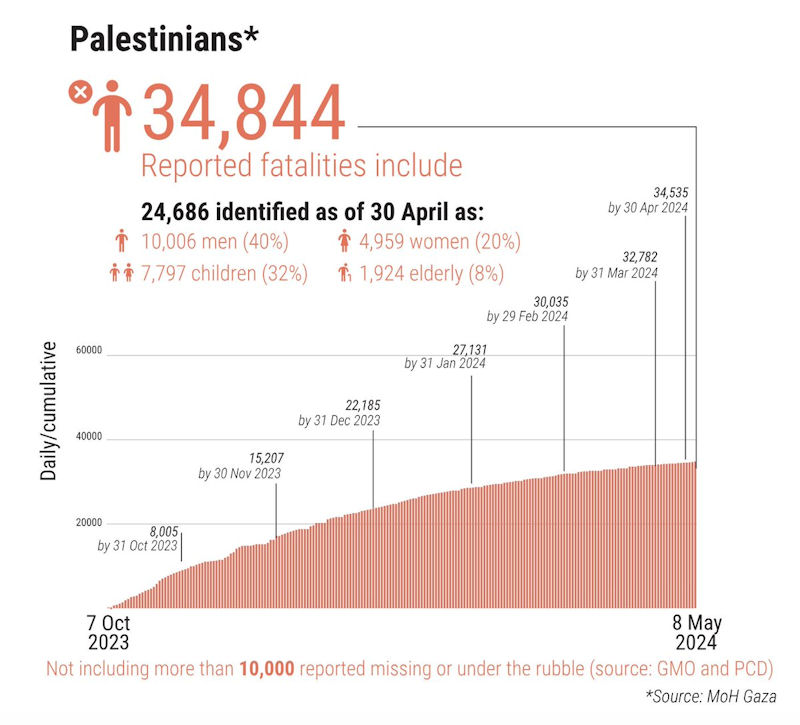
 Eurasia Press & News
Eurasia Press & News
